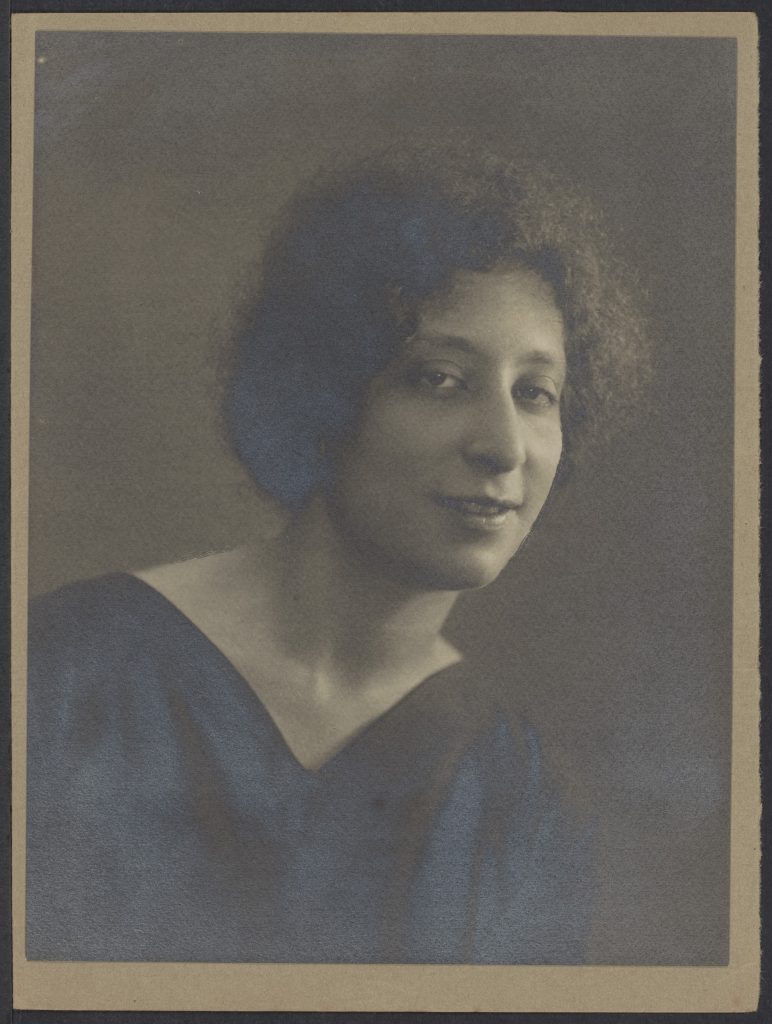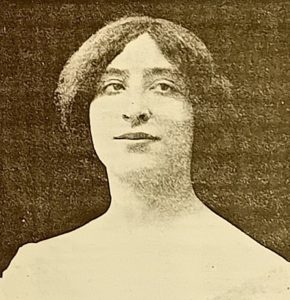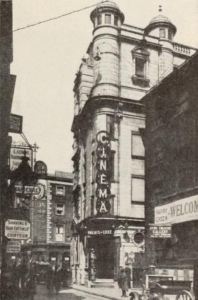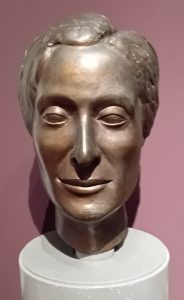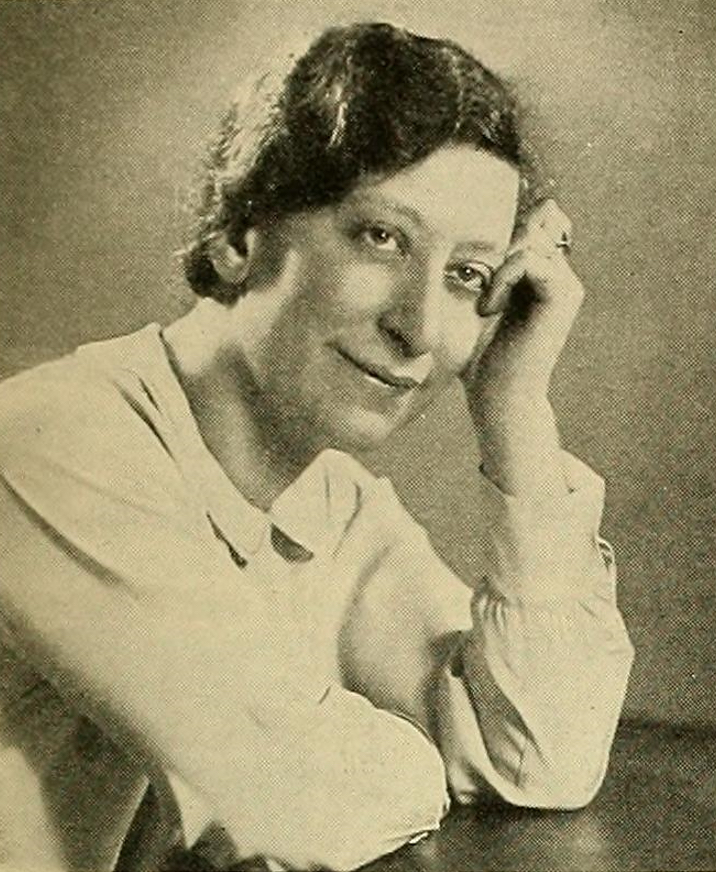Elsie Cohen was one of the most versatile and influential figures within British film culture in the first half of the twentieth century. After making her mark as a film journalist in Britain and a publicity and film sales manager in the Netherlands, she found fame as the manager of art house cinemas, notably the Academy in London, playing a huge part in spreading the appreciation of film as art in the 1930s. Because of the importance of her time at the Academy, this profile goes into the sound era. However, each part of Cohen’s career derived from the same idealistic sense of mission, and her pioneering work in so many aspects of silent film cannot be separated from the later parts of her career.
She was born Elsa Cohn, the only daughter among the four children of Polish Jews Josef Cohn and his wife Jennÿ (née Herbst). Josef Cohn was a commercial traveler in textiles who moved his business from Berlin to Amsterdam in the mid-1890s, where Elsa was born on June 14, 1895. By 1898, the family had relocated to London. Aside from short periods spent working in the Netherlands and Germany in the 1920s, Elsa Cohn lived in Britain for the rest of her life, becoming a naturalized Briton in 1925.
In 1915, having attended a journalism school, she joined the film trade paper Kinematograph and Lantern Weekly as a junior subeditor, adopting the professional name of Elsie Cohen (Slide, “Elsie Cohen Interview” 16). She swiftly demonstrated the enterprise, organizational skills, and enthusiasm that became the bedrock of her career. She also developed a lifelong passion for film, which was sealed by an interview she secured with D. W. Griffith in 1917 while he was in London promoting Intolerance (1916), a film for which she never lost the enthusiasm revealed in her ecstatic review of its British premiere:
Never, perhaps, with all its past glories have the rafters of Drury Lane Theatre re-echoed with the shouts and applause of the people as they did for David Wark Griffith’s inspired work, “Intolerance.” Spellbound, the vast audience sat for three hours, now swayed almost to tears by the power and pathos of the silent drama so vividly depicted, now thrilled by the vastness and magnitude and grandeur of the old Babylonian city and the old-time warfare, so unlike and yet so like that which is tearing the world’s heartstrings to-day. And through it all sat, imperturbable, the genius who had conceived this masterpiece, the man to whom the world of kinematography owes such a debt of gratitude. (Cohen, “An Impression of ‘Intolerance’”)
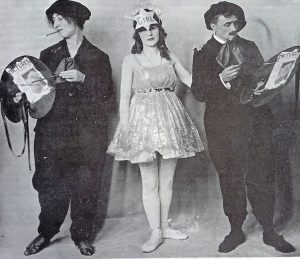
Elsie Cohen (left) in costume for a 1919 cinema ball during her time at Pictures and Picturegoer, standing beside Lavender Lee and the journal’s editor Fred Dangerfield. Private Collection.
At this time, Cohen was one of ten staff members at the Kinematograph and Lantern Weekly, of whom two were women (Miss C. R. Clarke worked in the advertisement department) (“Old and New Members”). As subeditor, she had oversight of all content and was recognized as preeminent among the women working in British film journalism (Reed). Later in 1917, aged just twenty-two, she was promoted to associate editor, while also serving as film critic and fashion writer for the weekly newspaper The National News (Who Was Who, vol. 1, 326).
In 1919, Cohen moved to another film trade journal, Pictures and Picturegoer, as associate editor, forming a dynamic double act with editor Fred Dangerfield. Her contributions there included several lively and well-crafted adaptations of narratives from current films (e.g., Cohen, “Comrades”). By then, she had become a familiar and trusted figure within the industry, aided by her serving as honorary secretary of the Cinema Trade Benevolent Fund, for which she enthusiastically organized, and participated in, cinema charity dances and events (“The Gymkhana”).
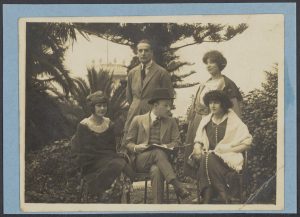
Still from the set of Kitty Tailleur (1921). Cohen is standing in the back. Courtesy of Eye Filmmuseum.
Cohen spent a year with Pictures and Picturegoer before making a bold move into film production in the Netherlands. At the recommendation of her film actress friend Mary Odette, Cohen joined the British-Dutch film company Anglo-Hollandia as its publicity manager and foreign sales manager (Slide, “Elsie Cohen Interview” 18). As publicity manager, ensuring that Anglo-Hollandia films were noticed, she quickly made her mark. She understood the need to pamper the press, being rewarded by many good notices when she brought a literal boat-load of British journalists to the town of Haarlem, where the company was based, to learn about Dutch culture and film (“In en om Haarlem”). One of her guests noted that Cohen’s activities were “so far-reaching that her office is hard to classify. In addition to directing studio publicity… Miss Cohen assists largely in the selection of play material, in research work, and in the general organisation of the studio. Also she is everybody’s good friend and tireless helper – ‘little mother’ to British artists in a strange land, and human encyclopaedia to all journalists” (“Wonder Days in Holland”). She also edited the Anglo-Hollandia Film News journal and was a bit part player in two Anglo-Hollandia films, both considered lost today: Kitty Tailleur (1921) and Zuster Brown (1921) (Donaldson 207, 211).
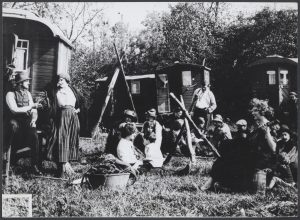
Promotional still for Zuster Brown (1920). Cohen is seated on the far right with the guitar. Courtesy of Eye Filmmuseum.
As foreign sales manager, she made the greatest impact. Anglo-Hollandia was formed in 1919 out of an alliance between the Dutch production company Hollandia, led by Maurits Binger, and the British distributor Smith’s Film Sales, to make films for the British market with a combination of British and Dutch talent. The following year, Binger struck a fresh production deal with British firm Granger’s Exclusives to produce films aimed at the American market, under the name Granger-Binger (“Grangers Secure Anglo Hollandia Output”). This led to Cohen taking six Granger-Binger films to the United States in 1922, including an adaptation of John Galsworthy’s The Skin Game (1921), which was filmed in Britain with Cohen reportedly supervising its production (Seton, “Silent Shadows”).
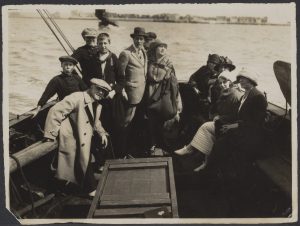
Members of the Hollandia film company on the Zuyder Zee in 1922. Maurice Binger is on the left (with cigar), Bulldog Drummond (1922) actors Carlyle Blackwell and Evelyn Greeley are in the center and Elsie Cohen is on the far right. Courtesy of Eye Filmmuseum.
In the United States, she secured a distribution deal with Producers Security Corporation and arranged for American film production talent to travel to the Netherlands (“American Company Going to Holland”). Cohen achieved this notable coup for the humble Dutch film industry after she outbid American companies for the rights to the hugely popular Bulldog Drummond stories from the author “Sapper” (H. C. McNeile), for £5,000 (Slide, “Elsie Cohen Interview” 19). Director Oscar Apfel and actors Carlyle Blackwell and Evelyn Greeley duly sailed from America to make the 1922 Bulldog Drummond in Haarlem, at the only film studio in the country (“Hollandia Will Produce in Europe”). On release, the film was generally praised by the American press and did good business (“Consensus of Published Reviews”).
When Binger died in 1923, Cohen took over the running of the company. However, according to her, the Dutch bankers financing Anglo-Hollandia were unable to contemplate the idea of a young woman managing a business, no matter how forward-thinking her ideas. Instead, they made the decision to close down the company (Slide, “Elsie Cohen Interview” 19).
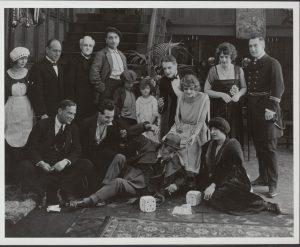
Still from the set of Gij zult niet doden (1922). Cohen is seated bottom right. Courtesy of Eye Filmmuseum.
Left at a loss, Cohen spent some time working at the UFA studios in Germany, though what role she had is unclear. There, she witnessed classic films, such as Der letzte Mann (1924) and Varieté (1925), being made. Few continental films made it to British screens, and then only sporadically. She began to develop ideas for improving how they might be exhibited in Britain (Morgan). Intriguingly, in 1924, she was secretary for Britannia Films when that company was set up by Dinah Shurey, Britain’s only female director of the 1920s, though the association appears to have been a short one (“Legal and Financial Digest”). Cohen reemerged on the British scene in 1927, working for Ideal Film Company as a studio manager, helping to rescue the troubled production of His House in Order (1928), where her tasks included retrieving the film’s star, a drug-addled Tallulah Bankhead, from a Paris hotel (Slide, “Elsie Cohen Interview” 19-20). She undertook a similar production support role for the Anglo-German Sir or Madam (1928), where her duties included serving as an interpreter for its director Carl Boese (Cohen spoke Dutch, English, French, German and Italian) (Morgan).
Cohen found her special vocation in 1930. She had friends who were financially supporting Laura Henderson’s purchase of a central London cinema, the 600-seat Palais de Luxe, with plans to convert it into the Windmill Theatre, later famous for its risqué wartime revues. Cohen was allowed to lease the cinema for a few months, making it into a repertory theater for overseas films (Slide, “Elsie Cohen Talks” 9). Subsequent claims that she had formed the country’s first art house cinema are inaccurate. There had been short repertory runs of foreign films (i.e., not American or British) in a number of London cinemas in the 1920s, referred to by some as the “Unusual Film Movement,” culminating in the repertory films shown between 1927-1929 at the Shaftesbury Avenue Pavilion, managed by Stuart Davis (Low 15; Rotha). Additionally, starting in 1925, the Film Society, of whose council Cohen would become a member in 1936, exhibited revivals, experimental, and new films on Sunday afternoons at the New Gallery Kinema and then the Tivoli (Sansom 307-308).
Opening in June 1930, the Palais de Luxe under Cohen’s management showed a mixture of American classics—The Circus (1928), Wings (1927), The Iron Mask (1929)—and German and Russian titles that had previously been available in Britain—Turksib (1929), Der heilige Berg (1926), Metropolis (1927), and Der letzte Mann (Mannock; O’Rourke). Of necessity she programmed silent films, as the cinema was not equipped for sound, but even as the talkies emerged her heart remained with the silent medium. As she said in an interview toward the end of her life, “I had some regret when sounds came in. I thought at that time that somehow silence belonged to the film” (Slide, “Elsie Cohen Talks” 13). She would be similarly skeptical of color (“Academy Manager Rejects Colour”).
The Palais de Luxe venture lasted for a few months, until the end of 1930. It had been a useful experiment. It proved that a market existed for niche programming and helped establish Cohen’s reputation as a cinema manager. She then learned of another London cinema that was potentially available: the Academy at 161-167 Oxford Street. It was originally known as the Picture House when it opened in 1913, though the site had been preceded by a Hale’s Tours proto-cinema show that operated between 1906-10 (Eyles and Skone 34). In 1929, the cinema was acquired by Anglo-Armenian musician-turned-exhibitor Eric Hakim through his company Cinema House Ltd. The Academy was a modest-sized cinema for the period, seating 534 (Eyles and Skone 35), but its location in the middle of London’s central commercial thoroughfare made it eye-catching. Stuart Davis and filmmaker Paul Rotha each approached Hakim with proposals but were deterred by the cost (Rotha). Cohen, however, made a successful bid, thus beginning a remarkable decade as manager of the most significant British cinema of its era.
The cinema reopened on March 30, 1931, with Le Roi des resquilleurs (1930), the start of a season of French films (“Hakim’s Foreign ‘Talkie’ Season”). The praise that was originally directed at Hakim for the venture was soon transferred to Cohen, as the programming broadened. A succession of eye-catching new titles, notably Kameradschaft (1931) and Mädchen in Uniform (1931), was programmed in combination with by-now established world classics, such as La Passion de Jeanne d’Arc (1928) and Konets Sankt-Peterburga (1927), as what had previously been seen as “unusual” was now viewed as essential. The idea of a permanent art house cinema caught London’s attention and led to acclaim from critics for Cohen’s enterprise. Within a year of the cinema opening, drama critic James Agate described her as being “the extremely clever directress of what is far and away our best picture-house” (Agate). Elizabeth Coxhead, in a piece on Cohen for Close Up, the journal devoted to film as art, called the cinema “a nucleus of intelligent film thought, a meeting-ground and a clearing house for ideas” (Coxhead 136). The cinema became the expression of the ambitions of the films that it was showing.
Cohen stated that the mission of the Academy was “to remain permanently a house for all that is cultural, unusual and outstanding in film art” (Coster 16). It was the place where many classic films were first seen in Britain, titles such as La Kermesse Héroïque (1935), La Grande Illusion (1937), Le Quai des Brumes (1938), and La Règle du Jeu (1939). Though French cinema became a hallmark of Academy programming, Cohen introduced Austrian, Czech, Dutch, Finnish, German, Hungarian, Italian, Russian, Swedish, and Swiss films, aided by her considerable contacts and regular visits to the Continent (Morgan).
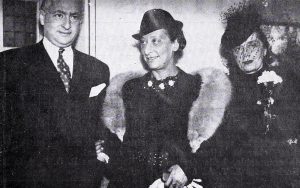
Left to right: M. Algazy, Elsie Cohen, and Princess Marthe Bibesco, attending the British premiere of Katia (1938) at the Academy, in La Cinématographie française, November 1939.
Cohen’s great gift was for promotion. She ensured that the Academy hosted prestige premieres, such as that of Le Dernier Milliardaire (1934), attended by its director René Clair. Royalty occasionally visited (the Duke and Duchess of Windsor attended the premiere of Maurice Tourneur’s Katia in 1938), while, at one screening, Cohen was told by Lord Samuel, leader of the Liberal Party, that there were enough ministers in the building that they could hold a Cabinet meeting (Slide,“Elsie Cohen talks” 10). Cohen was also skilled at promoting herself: her name regularly featured in the cinema’s advertisements, generally with the line “Organiser Miss Elsie Cohen.” This was the programmer as star.
Promotion was aided by the use of mailing lists to build up awareness of films and foster a sense of community. The Academy not only served its audience but also acted as information source and support for many amateur film societies in need of advice in locating films. Cohen’s ambition was to establish a set of regional Academies, but suitable venues were difficult to find. Only the Leeds Academy Cinema, which opened in September 1933 and ran for a couple of years, was to see the light of day, though Cohen did briefly open a successor Leeds cinema showing continental films, the Tatler, in 1939 (Miller; “Continental Films for Leeds”).
Cohen was innovative in the presentation of films. In particular, she was influential in the use of subtitles instead of dubbing, insisting that all non-English language films shown at the Academy were subtitled and encouraging developments in their production as managed by her enterprising assistant Elizabeth Mai Harris (Low 100). Cohen introduced morning screenings for schoolchildren in January 1932, a combination of Continental, American, and British films (“Films for Children”). She repeated the initiative over the November 1934-January 1935 period under the title Junior Academy, noting that the parents were of far greater trouble than the children, some confronting her in the foyer wanting to know “how dare she show their children a revolver” (Staples 49). Films with foreign dialogue brought in regular visits from groups of language students (Cohen, “The Continental Film in England”).
Cohen also supported filmmakers. In the late-1930s, she worked with the film critic Marie Seton in an attempt to rescue Sergei Eisenstein’s unfinished ¡Que viva México! The plan was for a group of backers to purchase the footage from the film’s sponsor, the author Upton Sinclair, and ship the rushes to Moscow for Eisenstein to edit. When these plans fell through, following the outbreak of war, Seton went to Los Angeles and paid for the film herself, resulting in her re-edit, Time in the Sun (1941) (Eisenstein 1898-1948, 21). Seton, one of Cohen’s strongest supporters, was friends with the Jamaican modernist sculptor Ronald Moody, which led to his striking bronze bust of Cohen, created at this time and now displayed in the National Portrait Gallery in London (Moody).
According to Cohen, Academy proprietor Eric Hakim “knew nothing whatsoever about foreign films” (Slide, “Elsie Cohen Talks” 9), but the 1931 opening French season had been his idea and he was a supportive and enthusiastic owner. In 1932, they leased a second, larger cinema for six months, the Cambridge Theatre in London’s Seven Dials area, making a powerful impact with Fritz Lang’s M (1931) (Orme). The following year, Hakim opened the Cinema House Theatre, on Oxford Street, again with Cohen managing. This continued until 1934 when it was acquired by another circuit (Slide, “Elsie Cohen talks” 10; Eyles and Skone 25). This was not unconnected with Hakim going bankrupt in 1934, having resigned as managing director of Cinema House Ltd, the Academy’s owner, in 1933. Cohen continued as manager of the Academy (“Elsie Cohen and the Academy”). A new company, Academy Cinema Ltd, took over ownership from Cinema House in 1937 with Cohen once again retained as manager.
In 1937, Cohen took on a deputy, George Hoellering, an Austrian director who had gained a strong reputation for his Hungarian drama-documentary Hortobágy (1936), duly shown at the Academy. Hoellering matched Cohen for enterprise and dedication to film as art, and was soon greatly involved in shaping the direction of the business (Taylor 185). A significant fruit of this new teaming was Unity Films. Formed in 1937, the company’s original goal was the distribution of 35mm films, often titles that had been exhibited at the Academy. Cohen was managing director, with co-directors Herbert Cohn (her younger brother), Hoellering, and millionaire communist Basil Burton, who was nephew of Daily Mail owner Lord Rothermere and chairman of left-wing film distributors Kino (Ryan 248).
Burton and Hoellering brought an increased political edge to the Academy. Cohen viewed herself as being non-political, but she was a member of the pacifist League of Nations Union, had experienced protests from right-wingers at her programming of Soviet classics, and, by 1937, had stopped programming German films at the Academy (Slide, “Elsie Cohen Talks” 11-12). The first film handled by Unity was Joris Ivens’s Spanish Civil War documentary Spanish Earth (1937), which showed that the Fascists had military support from Nazi Germany (news of which had been hidden from the British people). Cohen fought censorship and objections from the Foreign Office to get the film screened with minimal cuts. Another coup was the premiere of the Russian film Professor Mamlock (1938), about the persecution of Jews in Nazi Germany, which had been refused a license by the British Board of Film Censors at a time when government policy was not to offend Hitler (Eyles, “The Academy Cinema” 8).
Uncertainty for the Academy arose with a rival art house cinema. London had other such cinemas in the 1930s, including the Everyman, the Forum, and Studio One, but the Academy had been very much the leader (O’Brien 688). However, competition from Pedro de Casa Maury was a direct challenge to this authority. Backed by funds greatly exceeding that which the Academy could command, he first proposed to build a new Academy, then put his money into the Curzon cinema in Mayfair. He could pay far higher prices for films, and the Academy suffered as a result (Slide, “Elsie Cohen Talks” 12).
However, 1939 was shaping up to be a pivotal year for Cohen. She took on de Casa Maury by opening a new cinema, the Berkeley, in Berkeley Square, close to the Curzon (“Elsie Cohen Acquires Berkeley, Mayfair”). She had revived her plans for eight regional Academies (“Woman’s Cinema Chain”), succeeding at least with the Tatler in Leeds (Miller). Her company Unity Films was planning to branch out into production with a feature film, One Out of Millions, to be directed by Hoellering. It was also building up its distribution side, with a strong line-up, including Mayerling (1936), La Grande Illusion (1937), and La Marseillaise (1938), linked to the startling development—wholly contrary to Cohen’s previous policy—of a system for dubbing foreign films into English, managed by Austrian technician K. H. Frank (“Unity’s Big Programme”). The Academy was devoting itself to all aspects of the art film—production, distribution, exhibition, and education—which promised much for the future. But the outbreak of World War II halted all its ambitions.
It was hazardous to have a cinema in central London during the Blitz. Bomb damage caused the Academy to close in October 1940. Cohen, who had been living in the Marble Arch area of London, was herself bombed out of three flats and her health was badly affected (Slide, “Elsie Cohen Talks” 12). With the Austrian Hoellering interned, and Burton serving in the Army, the Academy and Unity Films were put under receivership for four years (Eyles, “Cohen [married name Kellner], Elsie”). Deprived of her cinema work, Cohen joined the Entertainments National Service Association (ENSA), which provided entertainment for British forces overseas. She managed its Overseas Recorded Broadcasting Service, which made and distributed recordings of entertainment, often derived from BBC radio programs. Cohen took particular pride in having negotiated with the Red Cross to deliver recordings to British prisoners of war in Germany (“Overseas Recorded Broadcasting Service”).
The Academy reopened in March 1944, but with George Hoellering as its manager. What exactly happened remains unclear, but it seems that Cohen took advice from someone— Marie Seton believed there was deceit on the part of Hoellering—to part with her interest in the Academy, at a time when her focus was on ENSA and her health was poor (Kilmister; Seton, Letter). A notice in Variety in February 1944 had stated that the cinema was “to be re-opened by Elsie Cohen with foreign film policy, as formerly,” which might suggest confusion or merely the assumption that the role would be hers (“London”). All that the deeply distressed Cohen knew was that “my beloved Academy was no longer mine” (Slide, “Elsie Cohen Talks” 12).
The Academy remained at its Oxford Street location under Hoellering’s management, with, for a time, Basil Burton’s directorship. It continued the art house policy that Cohen had established while building on its iconic status through imaginative programming and the stylish posters of Peter Strausfeld. It closed in 1986 (Taylor 185). Cohen continued working for ENSA’s Overseas Recorded Broadcasting Service until 1948, when she joined Levy’s Sound Studios in London as a director and general manager (“Chit Chat”). Thereafter, her life becomes private. She had married a Hungarian homeopathic doctor resident in London, named Endre (anglicized as Andrew) Kellner, in 1933. The marriage ended in divorce in 1936, and there were no children. She kept the name Kellner but professionally remained Elsie Cohen (In the High Court of Justice).
Elsie Cohen died in Brighton in 1972, after a long illness. She had moved to the Sussex area, where some family members had settled, in the late 1930s. In a heartfelt tribute after her death, senior figures in film culture Sidney Bernstein, Denis Forman, Ivor Montagu, and Marie Seton wrote: “Expansive and generous by nature… She will be remembered with gratitude by all those who worked for the recognition of film as an art and the broadening out of audiences previously confined to film societies or occasional commercial releases” (Bernstein et al.). Cohen was driven by idealism as much as enthusiasm in every field in which she pioneered: from journalism, publicity, sales, and studio management during the silent era to art house exhibition and distribution in the sound era. She represented the higher things to which cinema aspired.

